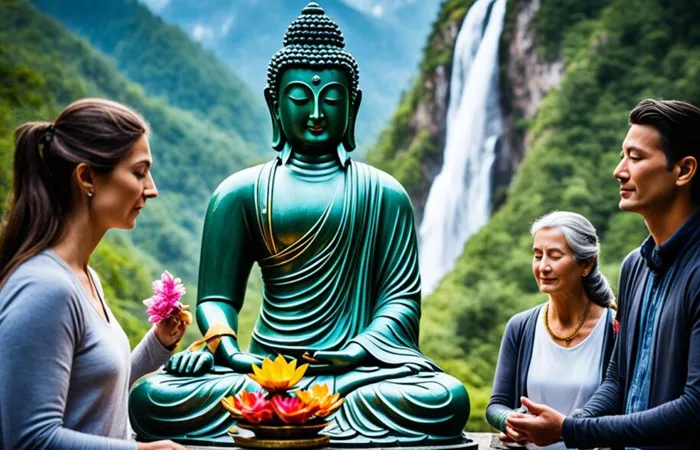Mahayana Buddhism is one of the main branches of Buddhism. It is known as the “Great Vehicle” because it seeks to help all beings achieve enlightenment. Unlike some other forms of Buddhism that focus mainly on individual liberation, Mahayana emphasizes saving others as well. The ideal figure in Mahayana is the Bodhisattva, someone who chooses to stay in the cycle of life to assist others on the path to awakening.
The Origins and Spread of Mahayana Buddhism
Mahayana Buddhism began in India more than two thousand years ago. From there, it spread across Asia, reaching countries such as China, Japan, Korea, Tibet, and Vietnam. The spread was supported by important Buddhist texts, such as the Lotus Sutra and the Prajnaparamita Sutras. These scriptures introduced new ideas about emptiness and compassion that became central to Mahayana thought.
The Core Teachings of Mahayana Buddhism
The heart of Mahayana Buddhism lies in two main teachings: emptiness (shunyata) and the Bodhisattva path. Emptiness means that all things lack an independent, permanent self and are interconnected. The Bodhisattva path is about practicing compassion and wisdom to help others reach enlightenment. Together, these teachings encourage kindness, selflessness, and deep understanding.
Different Schools Within Mahayana
Mahayana Buddhism includes many different traditions and schools. Each has its own style and practices but shares the same goal. Some important schools are:
- Zen Buddhism: Focuses on meditation and direct insight into the nature of mind.
- Pure Land Buddhism: Centers on faith in Amitabha Buddha and rebirth in a blissful Pure Land.
- Tibetan Buddhism: Combines philosophy, rituals, and tantric practices.
Despite their differences, all these schools teach compassion, wisdom, and the aim of benefiting all beings.
The Global Influence of Mahayana Buddhism
Mahayana Buddhism is practiced by millions around the world today. It has grown beyond its Asian origins to become a global spiritual path. Its teachings on compassion and mindfulness have attracted many people interested in spiritual growth and inner peace.
Mahayana Buddhism and Modern Life
In modern times, many people use Mahayana teachings to improve daily life. Meditation and mindfulness help reduce stress and increase happiness. The Bodhisattva ideal inspires people to act kindly and support others in their communities. This practical use of ancient wisdom helps Mahayana Buddhism stay relevant and meaningful.
The Destiny of Mahayana Buddhism
The destiny of Mahayana Buddhism is to continue its path of compassion and wisdom. It will grow as more people learn its teachings and apply them in their lives. The Bodhisattva ideal remains a powerful inspiration for those who wish to serve others and create a more peaceful world.
The Role of Practitioners
Practitioners of Mahayana Buddhism carry the future of the tradition. By living with kindness, practicing meditation, and studying the Dharma, they keep the teachings alive. Their daily actions help spread the spirit of Mahayana, touching many lives with peace and compassion.
The Role of Teachers
Teachers guide students and communities in understanding and practicing Mahayana Buddhism. They share the teachings through talks, writings, and meditation sessions. In today’s world, teachers use new ways such as online platforms to reach more people and bring Mahayana teachings to wider audiences.
How Mahayana Buddhism Can Flourish
Mahayana Buddhism flourishes by encouraging practical compassion and wisdom in everyday life. It helps people develop inner peace while also caring for others. Its teachings on emptiness and interconnection invite a deep respect for all living beings and the environment.
The Importance of Compassion
Compassion is the foundation of Mahayana. It calls for helping others with kindness and understanding. This quality can create harmony within families, communities, and even between nations. By spreading compassion, Mahayana Buddhism contributes to a better world.
The Importance of Wisdom
Wisdom in Mahayana means seeing the true nature of reality—understanding that everything is connected and ever-changing. This insight helps people let go of selfishness and find freedom from suffering. Wisdom and compassion together guide the path of the Bodhisattva.
Conclusion
The destiny of Mahayana Buddhism is hopeful and inspiring. It is a living tradition that continues to grow and adapt while holding on to its essential teachings. By following the path of compassion and wisdom, Mahayana Buddhism will keep helping beings around the world find peace and enlightenment.

